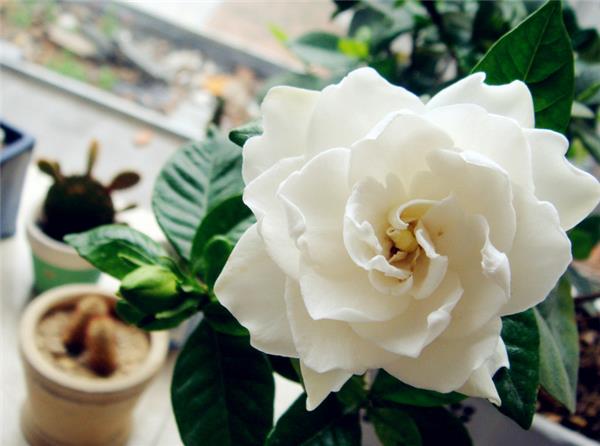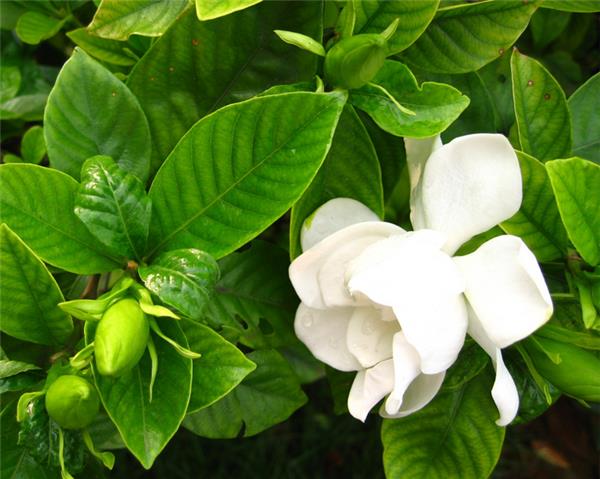How to raise gardenia well
Gardenia flower language is "strong, eternal love, life waiting, our love" very beautiful sustenance, gardenia love decryption: from spring to early summer can see gardenia white flowers, elegant aroma so that people can not ignore her existence, so how to raise gardenia?

How to raise gardenia well
Gardenia is a typical acid soil plant, afraid of alkaline soil. Gardenia like fertilizer, it is summer, you should water more, and every morning and evening with water spray leaves and hot weather and sprinkle water on the ground to cool and humidify, at noon, do not let it exposure, otherwise the leaves must be yellow. Always keep the basin soil moist. Water 0.2% ferrous sulfate or alum fertilizer water every half a month (but do not abuse ferrous sulfate) to supplement soluble iron in the soil and prevent leaves from yellowing.
In addition, domestic gardenia should master its physiological characteristics in order to make the leaves, flowers and fruits beautiful and improve the ornamental value.
1. Acid-loving soil: soil, water and fertilizer contain iron, which makes the plant unable to absorb iron, which affects the formation of chlorophyll, withering branches, scorching leaves, and even death. To use fertile, loose, well-drained acid soil, such as pine sawdust thoroughly mixed into the soil, the use effect is also very good.

two。 Like shade: avoid scorching sun exposure, but often some people mistakenly think that gardenia requires full shade, resulting in mistakes in cultivation. In fact, while paying attention to cultivating its shady environment, it is necessary to maintain 60% light throughout the day in order to meet the needs of its growth.
3. Like dampness: if the air humidity is less than 70%, it will directly affect flower bud differentiation and bud growth, but too wet will cause root rot and branch withering, leaf yellow shedding phenomenon. In addition to normal watering, foliar and nearby ground should be sprayed with clean water frequently to increase air humidity appropriately.
4. Like fertilizer: it is appropriate to apply fermented bean cake, sesame sauce dregs, peanut bran and other fertilizers, which can be acidic after fermentation, but must be applied with thin fertilizer, avoid thick fertilizer and raw fertilizer, and do not apply fertilizer during hibernation. If you have been planting for less than three years, do not give human faeces and urine. Too much nitrogen fertilizer will result in thick branches, large leaves, thick green, but no flowering. Lack of phosphorus and potassium fertilizer will also appear the phenomenon of non-flowering or bud withering and shedding.

5. Liking temperature: 18 ℃ to 22 ℃ in the growing period, 5 ℃ to 10 ℃ in the overwintering period, and freezing if the temperature is lower than-10 ℃.
6. Timely pruning: gardenia has strong sprouting power, easy to overlap branches, airtight and dispersed nutrition. In normal shape, three main branches should be selected according to the shape of the tree, and other branches sprouting from root tillers should be cut off at any time. After the flowers fade, the branches should be truncated in time to promote the germination of new branches under the cut mouth. Pick the heart after the new branch grows three nodes to avoid growing blindly.
7. We should prevent yellowing. There are four causes:
① is iron deficient. The soil contains too much limestone, calcium, phosphorus, manganese, etc., which will affect the absorption of iron by plants, affect the formation of chlorophyll, make the veins of tender leaves green and spread throughout the leaves. 1pm 500 ferrous sulfate or 0.2% black alum can be applied every 10 days.
② is magnesium deficient. Acid red soil and excessive potassium and ammonium are prone to magnesium deficiency, which makes the veins of the old leaves in the lower part of the plant green and yellow, which can be sprayed with 1% to 2% magnesium sulfate solution, but excessive application of magnesium will cause calcium deficiency and hinder the development of xylem in roots and stems.
③ basin soil is too wet or too dry.
④ is exposed to the sun in summer.

If you ask me, how about planting a gardenia at home? I will certainly answer: very much.
His appearance makes you feel impeccable. We usually say that gardenia has great appreciation value, how can he have appreciation value? Gardenia has luxuriant branches and leaves, evergreen leaves, fragrant and elegant flowers, green leaves and white flowers, especially beautiful and lovely, which is an excellent beautification material in the courtyard. It is suitable for the configuration of the front steps, poolside and roadside, and can also be used as hedges, potted plants and bonsai. The flowers can also be used for flower arrangement and decoration. A delicate and moving floret sends out a fresh fragrance from time to time, which makes people nostalgic to and from.
2. It can make the home environment change qualitatively. The biggest characteristic of a gardenia lies in its flower fragrance. As long as you plant one at home, you can smell it in hundreds of square meters. Just imagine, in your home, the space is about 100 square meters. No matter which corner you go, you can smell gardenia. What a pleasure it should be!
3. He absolutely plays an important role in beautifying the home. If you put a gardenia next to the TV at home, in addition to beautifying the indoor space and absorbing harmful indoor radiation, it also emits a delicate fragrance from time to time, masking the original insipid or even unpleasant smell, exchanging air to the space and making the whole family full of poetry.
4. Living in the space of gardenia, people will become healthier. When one lives alone, the quality of the air inhaled has a great impact on one's health. We always see that people in rural areas live longer and healthier, and they can still work in the fields when they are in their seventies, but not necessarily those who live in cities. At that time, they spend more time in hospitals. The biggest difference between rural and urban areas is that the air quality is different, and the ones in rural areas are obviously much better, so we put some gardenias at home. When the air at home is as fresh as in the countryside, longevity is not necessarily impossible.
In addition to beautifying the indoor space and absorbing harmful indoor radiation, it also emits fragrance from time to time, masking the original insipid or even unpleasant smell, exchanging air to the space, making the whole family full of poetry.
4. Living in the space of gardenia, people will become healthier. When one lives alone, the quality of the air inhaled has a great impact on one's health. We always see that people in rural areas live longer and healthier, and they can still work in the fields when they are in their seventies, but not necessarily those who live in cities. At that time, they spend more time in hospitals. The biggest difference between rural and urban areas is that the air quality is different, and the ones in rural areas are obviously much better, so we put some gardenias at home. When the air at home is as fresh as in the countryside, longevity is not necessarily impossible.
Related
- Wuhan Hospital Iron Tree Blooming Result Was Instantly Frightened by the Gardener Master
- Which variety of camellia is the most fragrant and best? Which one do you like best?
- What is the small blue coat, the breeding methods and matters needing attention of the succulent plant
- Dormancy time and maintenance management of succulent plants during dormancy
- Minas succulent how to raise, Minas succulent plant pictures
- What are the varieties of winter succulent plants
- How to raise succulent plants in twelve rolls? let's take a look at some experience of breeding twelve rolls.
- Attention should be paid to water control for succulent plants during dormant period (winter and summer)
- Watering experience of twelve rolls of succulent plants
- Techniques for fertilizing succulent plants. An article will let you know how to fertilize succulent plants.



